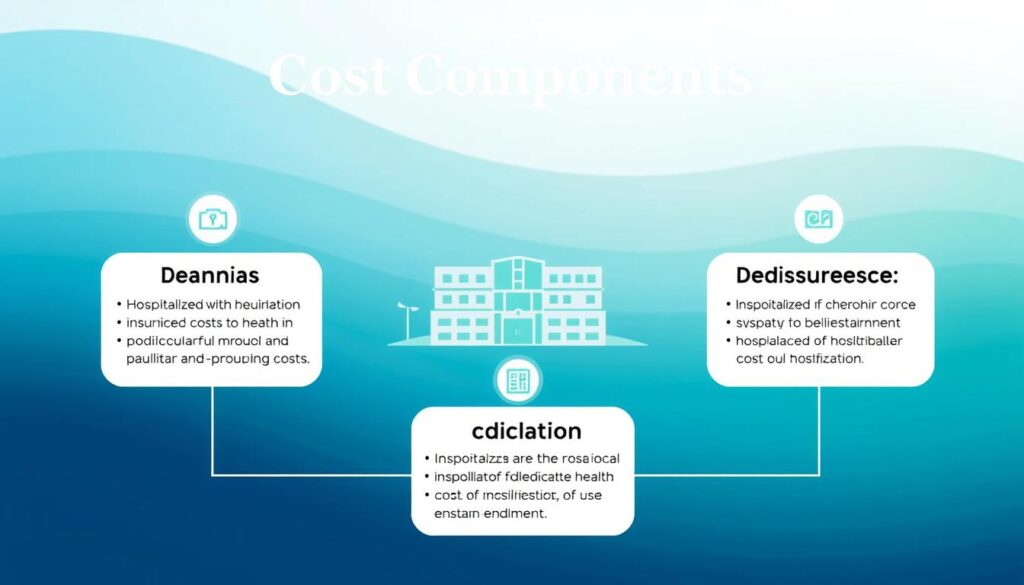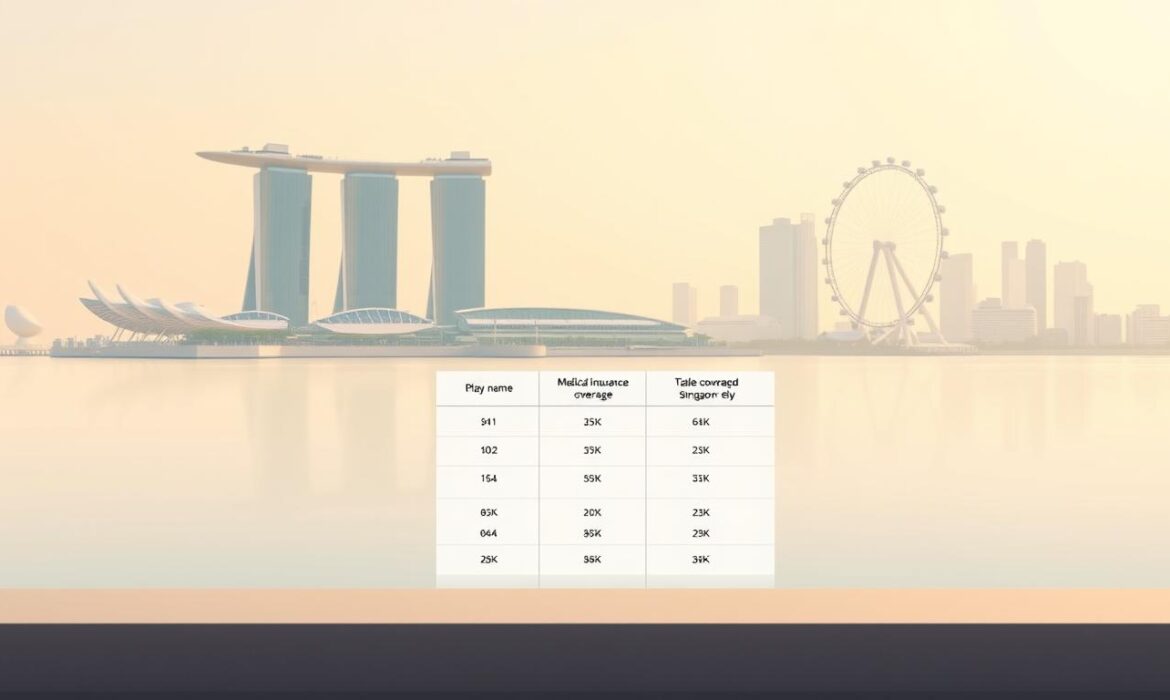Welcome to your complete guide for understanding medical protection plans in Singapore. We know healthcare choices can feel overwhelming.
This resource helps you compare top integrated shield plans from providers like Prudential and Great Eastern. You’ll see how these options work with MediShield Life.
We break down ward classes, coverage limits, and premium costs. Our goal is to help you find the right plan for your needs and budget.
You’ll learn smart ways to maximize benefits while keeping out-of-pocket costs low. Stay informed about recent changes in healthcare protection.
Key Takeaways
- Integrated Shield Plans work alongside Singapore’s basic MediShield Life coverage
- Different ward classes (A, B1, etc.) come with varying coverage levels and costs
- Premium structures differ between providers and plan types
- Understanding coverage limits helps prevent unexpected medical expenses
- Regular plan reviews ensure your protection matches your changing healthcare needs
- Leading providers offer different benefits for private hospital treatments
- Smart plan selection can significantly reduce out-of-pocket medical costs
Why Integrated Shield Plans Are Essential in Singapore
Singapore’s healthcare system operates on a unique dual-layer approach that combines public and private protection. This structure ensures everyone has basic medical security while offering options for enhanced coverage.
The foundation starts with MediShield Life, which provides essential protection for all citizens and permanent residents. Private integrated shield plans then build upon this base with additional benefits and choices.
Understanding MediShield Life’s Basic Coverage
MediShield Life serves as Singapore’s core health insurance program. It automatically covers everyone for major medical expenses throughout their lifetime.
This government-mandated scheme protects against large hospital bills and selected costly outpatient treatments. It offers a safety net for serious health conditions that require extensive care.
However, MediShield Life has certain limitations in coverage amounts and ward class options. The annual claim limits may not fully cover complex or prolonged medical treatments.
Basic coverage typically applies to public hospital Class B2/C wards. This means patients might face longer wait times for certain procedures and limited choices in healthcare providers.
How IPs Enhance Your Healthcare Protection
Integrated Shield Plans (IPs) significantly expand your medical protection beyond the basics. These private plans work alongside MediShield Life to create comprehensive coverage.
IPs provide access to private hospitals and higher ward classes in public hospitals (A/B1). This means shorter wait times for treatments and access to specialized care when you need it most.
The enhanced coverage includes significantly higher annual claim limits. This helps reduce out-of-pocket expenses for complex medical situations that require extensive treatment.
Many IPs also offer additional benefits like coverage for pre-existing conditions after waiting periods. Some plans include riders that further minimize your financial responsibility during medical claims.
| Feature | MediShield Life | Integrated Shield Plans |
|---|---|---|
| Annual Claim Limits | Basic coverage amounts | Significantly higher limits |
| Hospital Ward Options | Public B2/C wards only | Private hospitals & A/B1 wards |
| Wait Times | Standard public system timing | Shorter wait times available |
| Specialized Care Access | Limited to public system | Broader specialist network |
| Out-of-Pocket Costs | Higher potential expenses | Reduced personal expenses |
Choosing the right combination of coverage helps ensure you’re prepared for various medical situations. The layered approach allows for flexibility based on your healthcare needs and budget.
Understanding these options empowers you to make informed decisions about your medical protection. Regular reviews of your plan ensure it continues to meet your evolving healthcare requirements.
Key Features of Top Hospitalization Insurance Plans
Quality medical protection plans offer diverse features that address various healthcare scenarios you might encounter. These comprehensive options provide peace of mind for unexpected medical situations.
Understanding what each plan covers helps you choose the right protection for your needs. Let’s explore the essential components that make these plans valuable.
Coverage for Inpatient and Day Surgery Treatments
Comprehensive plans include full coverage for hospital stays and surgical procedures. This means your room charges, nursing care, and medical procedures are covered.
Day surgery treatments receive the same level of protection as inpatient care. Many procedures that once required overnight stays now happen in day surgery centers.
Your plan should cover both planned and emergency surgeries. This ensures you’re protected regardless of when medical needs arise.
Psychiatric Treatment Benefits
Mental health coverage has become increasingly important in modern healthcare plans. Quality options offer significantly higher annual limits than basic government schemes.
These benefits typically range from $4,000 to over $20,000 per year. This allows for comprehensive treatment including therapy sessions and medication management.
Mental health is just as important as physical health. Having adequate coverage ensures you can access necessary care without financial stress.
Outpatient Coverage for High-Cost Treatments
Some of the most expensive medical treatments happen outside hospital walls. Comprehensive plans cover these outpatient procedures to reduce your financial burden.
Chemotherapy and radiotherapy treatments are typically included in quality plans. These cancer treatments can be ongoing and very costly without proper coverage.
Kidney dialysis is another high-cost treatment covered under outpatient benefits. Regular dialysis treatments are essential for many patients with kidney conditions.
“The right medical protection plan transforms healthcare from a financial worry into managed care. Comprehensive coverage means focusing on recovery rather than costs.”
Pre- and Post-Hospitalisation Coverage
Medical care doesn’t begin and end at the hospital door. Quality plans understand that treatment often involves preparation and follow-up care.
Pre-hospitalisation coverage typically includes consultations and diagnostic tests 90-180 days before admission. This ensures all necessary preparations are covered.
Post-hospitalisation protection extends up to 365 days after discharge. Follow-up appointments, medications, and rehabilitation are included in this coverage.
| Coverage Type | Typical Duration | Included Services | Annual Limits |
|---|---|---|---|
| Pre-Hospitalisation | 90-180 days | Consultations, tests, scans | Varies by plan |
| Inpatient Care | Unlimited days | Room, surgery, medications | Plan maximum |
| Post-Hospitalisation | Up to 365 days | Follow-ups, rehab, meds | Varies by plan |
| Psychiatric Care | Annual limit | Therapy, medication, care | $4,000-$20,000+ |
| Outpatient Treatments | As needed | Chemo, dialysis, radiation | Plan maximum |
Major organ transplants are covered when performed at recognized medical institutions. Each plan has specific limits and conditions for these complex procedures.
Some comprehensive options also cover congenital abnormalities and pregnancy complications. Certain plans protect against up to 36 different pregnancy-related conditions.
Understanding these features helps you identify the most suitable protection for your situation. Each component works together to create complete medical security.
Comparing Ward Class Coverage: Public vs. Private Hospitals
Understanding different ward classes helps you choose the right medical protection for your needs. Each option offers unique benefits and cost structures.
The choice between public and private coverage affects both your comfort level and premium costs. Let’s explore what each ward class provides.
Public Hospital Class B2/C Wards
Class B2/C wards represent the most basic accommodation in public hospitals. These shared rooms typically house 6-8 patients.
The government heavily subsidizes these wards, making them affordable. However, privacy and comfort levels are limited compared to higher classes.
MediShield Life primarily covers these ward types. Patients might experience longer wait times for certain procedures and treatments.
Public Hospital Class A/B1 Wards
Class A/B1 wards offer private accommodation within public hospital settings. These rooms provide more privacy, comfort, and personal space.
Patients enjoy choice of doctors and shorter waiting periods. The environment feels more comfortable while maintaining public hospital reliability.
Integrated Shield Plans typically cover these higher-class wards. The enhanced benefits come with moderately increased premium costs.
Private Hospital Amenities and Choices
Private hospitals offer the highest level of amenities and personalized care. Patients receive single rooms with premium facilities and services.
You get complete choice of specialists and minimal waiting times. The experience focuses on comfort and immediate attention.
This coverage requires comprehensive IPs with higher premium structures. The enhanced benefits come with significantly increased costs.
“Choosing the right ward class isn’t just about comfort—it’s about matching your healthcare expectations with practical financial planning.”
- Basic wards offer affordability but limited privacy
- Higher-class public wards balance comfort with cost efficiency
- Private facilities provide premium care at higher expense
- Each option serves different healthcare needs and budgets
- Your choice directly impacts both benefits and annual premiums
Consider your healthcare preferences and financial capacity when selecting coverage. The right balance ensures adequate protection without unnecessary expenses.
Regular reviews help maintain appropriate coverage as your needs evolve. Smart choices today prevent financial stress during medical claims.
Understanding Costs: Premiums, Deductibles, and Co-Insurance
Medical protection costs involve three key components that work together to determine your financial responsibility. Knowing how these elements interact helps you budget effectively for healthcare needs.
Your premium payments, deductible amounts, and co-insurance percentages create a complete picture of your expenses. Understanding each part ensures no surprises when medical situations arise.

How Age and Coverage Level Affect Premiums
Your age significantly impacts premium costs for integrated shield plans. Younger individuals typically enjoy lower rates while older policyholders pay more.
Coverage level choices also influence your premium amounts. Selecting higher ward classes or private hospital access increases your annual costs.
Most providers adjust premiums every policy year based on age brackets. This means your costs will gradually increase as you grow older.
Deductible Amounts Across Different Plans
Deductibles represent the initial amount you pay before your coverage begins. These amounts vary based on your chosen plan and age group.
Typical deductible ranges fall between $1,500 and $4,500 depending on ward class selection. Higher coverage options usually come with higher deductible requirements.
This initial out-of-pocket expense applies per policy year for covered treatments. Meeting your deductible activates your plan’s full benefits for subsequent claims.
The Role of Co-Insurance in Your Medical Bills
Co-insurance represents your share of costs after meeting the deductible. Most integrated shield plans require 10% co-insurance on remaining eligible bills.
This means you pay 10% of covered expenses while your plan pays the remaining 90%. The arrangement helps control overall program costs while maintaining comprehensive protection.
Some plans offer riders that can reduce or eliminate co-insurance requirements. These additional options provide more complete coverage but increase premium costs.
“Smart healthcare planning means understanding not just what’s covered, but how much you’ll actually pay when medical needs arise.”
Recent Ministry of Health announcements indicate changes coming between 2025-2028. Premium increases of up to 35% will reflect higher claim limits and expanded coverage benefits.
Annual claim limits will rise from $150,000 to $200,000 under these changes. Inpatient deductibles will also increase by up to $1,500 during this period.
These adjustments ensure sustainable protection that keeps pace with healthcare cost inflation. Understanding these changes helps you plan for future medical expenses effectively.
- Premium costs increase with both age and coverage level selections
- Deductible amounts typically range from $1,500 to $4,500 based on plan type
- Co-insurance usually requires 10% payment on eligible medical bills after deductible
- Recent MOH changes will increase premiums and deductibles through 2028
- Higher claim limits and expanded benefits justify these cost adjustments
These cost components work together to create balanced healthcare protection. Premiums maintain your coverage, deductibles control initial claims, and co-insurance shares ongoing expenses.
Understanding this structure helps you choose the right balance of protection and affordability. Smart decisions today prevent financial stress during future medical situations.
The Importance of Riders in Reducing Out-of-Pocket Expenses
Integrated shield plans provide solid protection, but riders take your coverage to the next level. These optional enhancements help manage costs when medical needs arise.
Riders work alongside your main plan to minimize financial surprises. They transform potential large bills into predictable expenses.
Understanding how riders function helps you make smart choices about additional protection. Let’s explore their key features and benefits.
Mandatory 5% Co-Payment and Caps
Since 2019, all new riders include a minimum 5% co-payment requirement. This means you share a small portion of each medical bill.
The co-payment is capped at $3,000 per policy year. This protection ensures your costs never exceed this limit regardless of treatment expenses.
This structure encourages thoughtful healthcare spending while providing financial security. You get comprehensive coverage with reasonable cost-sharing.
Additional Benefits from Riders
Riders offer more than just cost protection. Many provide extended coverage periods for pre- and post-hospitalisation care.
Some options include specific outpatient treatments not covered by basic plans. These enhancements address various healthcare scenarios you might encounter.
Rider premiums require cash payments since MediSave cannot be used. This additional cost brings valuable peace of mind during medical situations.
“Riders transform healthcare from a financial uncertainty into a manageable expense. The capped co-payment provides both protection and responsibility.”
- Optional add-ons that reduce your share of medical costs
- Minimum 5% co-payment with annual cap protection
- Extended coverage periods for comprehensive care
- Additional outpatient treatment options available
- Cash premiums for enhanced financial security
Choosing the right rider depends on your healthcare needs and budget. These enhancements work with your main plan to create complete protection.
Smart rider selection helps ensure you’re prepared for various medical scenarios. The combination provides both coverage and cost predictability.
How to Choose the Best Hospitalization Insurance in Singapore
Making smart choices about healthcare coverage involves balancing immediate needs with long-term financial planning. The right protection should serve you well today while remaining affordable throughout your life.
This decision requires careful consideration of multiple factors. Your choices will impact both your healthcare access and financial stability for years to come.
Assessing Your Healthcare Needs and Financial Capacity
Start by evaluating your current health situation and medical history. Consider any ongoing treatments or potential future healthcare requirements.
Family medical patterns can provide valuable insights. Lifestyle factors also influence your likely healthcare needs over time.
Financial planning is equally important. Premium costs increase significantly as you age, requiring long-term budget consideration.
Integrated Shield Plan premiums can be partially paid using MediSave funds, with withdrawal limits that vary by age. The remaining amount requires cash payments.
Higher coverage levels mean higher premium costs. Find the balance between comprehensive protection and affordable payments.
Considering Future Premium Increases
Age significantly impacts your premium costs. Younger individuals enjoy lower rates that gradually increase over time.
Buying protection early offers multiple advantages. You secure lower premium rates and avoid exclusions for conditions that might develop later.
Retirement planning should include healthcare cost considerations. Ensure your future income can support ongoing premium payments.
Premium structures typically increase every policy year based on age brackets. This gradual rise requires forward-thinking financial preparation.
“Smart healthcare protection isn’t just about today’s coverage—it’s about ensuring you can maintain that security throughout your life journey.”
Consider these key factors when selecting your plan:
- Current health status and potential future medical needs
- Ability to pay both MediSave and cash portions of premiums
- Long-term financial capacity, especially during retirement years
- Balance between comprehensive coverage and budget constraints
- Advantages of early enrollment for better rates and coverage terms
The ideal protection plan matches both your present circumstances and future possibilities. Thoughtful selection today prevents financial stress during future medical situations.
Regular reviews ensure your coverage continues to meet evolving needs. Adjustments might be necessary as your life circumstances change.
Top Integrated Shield Plans: A Detailed Comparison
Exploring different providers helps you find the perfect match for your medical needs. Each company offers unique features and benefits.
Understanding these options ensures you select the right protection for your situation. Let’s examine some leading choices available.
PRUShield Plans: Standard, Plus, and Premier
PRUShield provides three distinct tiers to match various healthcare preferences. Each level offers different ward class access and benefits.
The Standard option covers B1 wards in public hospitals and below. This provides solid protection with moderate premium costs.
Plus plans extend coverage to A wards in public facilities. Patients enjoy more privacy and shorter wait times.
Premier options offer comprehensive private hospital access. This includes standard rooms in private institutions and all public hospitals.
“The right plan choice balances your healthcare expectations with practical financial planning. Tiered options make this decision easier.”
PRUExtra riders enhance these core plans significantly. Options include Plus CoPay, Premier Lite CoPay, and Preferred CoPay.
These additions further reduce out-of-pocket medical expenses. They work alongside your main coverage for complete protection.
- Standard tier covers public hospital B1 wards and below
- Plus tier extends to A wards in public facilities
- Premier tier includes private hospital standard rooms
- PRUExtra riders minimize co-payment requirements
- PRUWell Reward offers 20% premium discounts for claim-free periods
- PRUPanel Connect enables cashless hospitalization at network facilities
Great Eastern and Other Leading Providers
Great Eastern offers competitive integrated shield plans with various coverage options. Their tiered approach matches different healthcare needs and budgets.
Other reputable providers include AIA, Aviva, and Income. Each company brings unique strengths to their medical protection offerings.
Comparing features helps identify the best value for individual situations. Consider both current needs and future healthcare requirements.
When evaluating options, review annual claim limits and coverage details. Ensure the plan matches your expected healthcare usage patterns.
Premium structures vary between providers and plan types. Consider both immediate costs and long-term payment capabilities.
Some plans offer additional health services and wellness programs. These value-added benefits can enhance your overall healthcare experience.
For more insights on medical protection options, explore our comprehensive provider comparison.
Remember that early enrollment often brings better rates and terms. Smart choices today ensure lasting healthcare security.
Special Considerations: Pre-Existing Conditions and Declarations
Your health history plays a crucial role in determining your coverage options and limitations. Some medical situations require special attention when selecting protection.
Understanding these factors helps you make informed decisions about your healthcare security. Let’s explore important considerations that affect your coverage.

The Impact of Non-Disclosure on Claims
Complete honesty about your medical background is essential when applying. Providers need accurate information to assess risk properly.
Withholding details about pre-existing conditions can lead to serious consequences. Your policy might be voided if important information is missing.
Claim rejections often result from incomplete medical declarations. This can leave you without protection when you need it most.
Always provide full details about previous treatments and diagnoses. Transparency ensures your coverage remains valid for future needs.
“Honest disclosure protects both your coverage and peace of mind. Complete transparency prevents unexpected claim denials.”
Coverage for Congenital Abnormalities and Pregnancy Complications
Congenital conditions receive different treatment across various plans. Some options offer benefits for diagnosis and treatment.
Coverage typically applies when symptoms appear after birth rather than at delivery. Conditions not classified as pre-existing may qualify for protection.
Pregnancy complication coverage varies significantly between providers. Some plans include specific conditions requiring hospital care.
Ectopic pregnancy and pre-eclampsia are commonly covered situations. Gestational hypertension may also receive protection under certain plans.
Higher-tier options might cover up to 36 pregnancy-related complications. The specific rider selections influence your actual coverage details.
- Complete medical disclosure ensures valid coverage
- Non-disclosure can result in claim denials and policy issues
- Congenital condition coverage depends on symptom manifestation timing
- Pregnancy complication protection varies by provider and plan level
- Some plans cover numerous pregnancy-related health situations
- Rider options significantly impact special condition coverage
- Understanding exclusions helps set realistic expectations
Review your policy terms carefully for special condition limitations. Knowing what’s covered prevents surprises during medical situations.
Your protection should match both current and potential future health needs. Smart choices today ensure comprehensive security tomorrow.
Using MediSave for Premium Payments: Limits and Strategies
Smart financial planning for medical protection involves understanding payment options. MediSave offers a convenient way to manage your premium costs while maintaining comprehensive coverage.
This system helps make quality healthcare protection more accessible to everyone. Knowing how to maximize these benefits can significantly reduce your out-of-pocket expenses.
Additional Withdrawal Limits by Age
MediSave withdrawal limits vary based on your age group. These restrictions help ensure sustainable healthcare funding throughout your life.
Policyholders aged 40 and below can withdraw up to $300 per year. This covers a portion of your integrated shield plan premiums.
Those between 41-70 years old have a $600 annual limit. Seniors aged 71 and above enjoy the highest allowance at $900 yearly.
These additional withdrawal limits apply to both MediShield Life and private components. The system ensures age-appropriate support for medical protection costs.
Cash Payments for Excess Premiums and Riders
Any premium amounts exceeding withdrawal limits require cash payment. This includes the private portion of your integrated shield plan coverage.
Rider premiums cannot be paid using MediSave funds at all. These enhancements always require complete cash payment.
Understanding these payment structures helps you budget effectively. Strategic planning considers both MediSave limits and cash flow requirements.
“Smart premium planning combines MediSave benefits with practical cash management. This approach makes comprehensive coverage more affordable for everyone.”
- MediSave covers basic MediShield Life premiums completely
- Integrated shield plan premiums receive partial MediSave support
- Age-based withdrawal limits determine available MediSave amounts
- Excess premiums beyond limits require cash payment
- Rider costs always need full cash payment
- Annual review helps adjust payment strategies
- Combined approach maintains coverage affordability
These payment options create flexible solutions for different financial situations. They help ensure continuous medical protection throughout your life.
Regular reviews of your payment strategy keep your coverage manageable. Smart financial planning today prevents coverage gaps tomorrow.
Recent Changes in Integrated Shield Plans
Staying current with medical protection updates helps you make informed decisions about your healthcare security. Recent adjustments affect both costs and treatment coverage options.
The Ministry of Health regularly reviews healthcare financing to ensure sustainable protection for everyone. These updates reflect changing medical needs and treatment advancements.

MOH Updates and Premium Adjustments
Significant premium changes are scheduled between 2025 and 2028. These adjustments help maintain comprehensive coverage as healthcare costs evolve.
Annual claim limits will increase from $150,000 to $200,000 during this period. This expansion provides better protection for complex medical situations.
Premium increases of up to 35% reflect these enhanced benefits. The changes ensure your plan remains effective against rising treatment expenses.
Cancer Drug List and Treatment Coverage
The Ministry of Health introduced the Cancer Drug List to manage treatment costs effectively. This list includes clinically proven and cost-effective medications.
Only CDL-listed cancer drug treatments are claimable under MediShield Life. Integrated Shield Plans follow the same guidelines for consistency.
Treatments must be administered exactly as described in the CDL documentation. This ensures proper usage and claim eligibility for patients.
The list undergoes regular updates to incorporate medical advancements. These changes help keep cancer treatment premiums sustainable long-term.
“Understanding recent healthcare updates ensures your protection remains aligned with current medical standards. Staying informed prevents unexpected coverage gaps.”
| Change Type | Implementation Period | Previous Limit | New Limit | Impact on Policyholders |
|---|---|---|---|---|
| Annual Claim Limit | 2025-2028 | $150,000 | $200,000 | Enhanced protection for complex treatments |
| Premium Adjustment | 2025-2028 | Current rates | Up to 35% increase | Higher costs for expanded benefits |
| Cancer Drug Coverage | Since April 2023 | Various medications | CDL-listed only | Standardized, cost-effective treatments |
| Treatment Guidelines | Ongoing | Provider discretion | CDL administration rules | Consistent claim eligibility requirements |
These updates help maintain quality healthcare protection for all residents. Understanding the changes allows for better financial planning and coverage selection.
Regular reviews of your plan ensure it continues to meet your evolving needs. Staying informed about Ministry of Health announcements prevents surprises during medical situations.
Tips for Maximizing Your Hospitalization Insurance Benefits
Getting the most from your medical protection requires smart planning and regular reviews. These strategies help you maintain excellent coverage while managing costs effectively.
Understanding how to optimize your plan ensures you receive maximum value throughout your life. Let’s explore practical ways to enhance your healthcare security.
Buying Young to Secure Lower Premiums
Purchasing coverage at a younger age offers significant financial advantages. Younger individuals typically enjoy lower premium rates due to better health profiles.
Early enrollment helps you avoid exclusions for conditions that might develop later. This ensures comprehensive protection as your healthcare needs evolve.
Locking in coverage while healthy provides peace of mind for future medical situations. You secure both affordable rates and broader protection terms.
“Starting early with medical protection creates a foundation for lifelong healthcare security. It’s one of the smartest financial decisions you can make for your future well-being.”
Downgrading Plans to Reduce Costs
Adjusting your coverage level can help manage premium expenses effectively. Moving to lower ward classes maintains essential protection while reducing costs.
These adjustments still provide solid medical security for most healthcare situations. You maintain continuous coverage without pre-existing condition exclusions.
Strategic downgrades work well during retirement or income changes. They help ensure your protection remains affordable throughout different life stages.
Regular policy reviews help identify optimal coverage levels for your current situation. Understanding when to adjust your plan prevents unnecessary financial strain.
| Strategy | Key Benefit | Consideration | Long-Term Impact |
|---|---|---|---|
| Early Enrollment | Lower premium rates | Health status requirements | Lifetime cost savings |
| Continuous Coverage | No pre-existing exclusions | Ongoing premium payments | Comprehensive protection |
| Plan Downgrading | Reduced premium costs | Lower ward class coverage | Maintained essential security |
| Regular Reviews | Optimal coverage matching | Time investment needed | Consistent value maximization |
Canceling your integrated shield plan completely removes all enhanced benefits. You would retain only basic MediShield Life coverage.
Reapplying later might prove difficult if new health conditions develop. These would likely be classified as pre-existing and excluded from coverage.
Premium rates would also be significantly higher due to increased age and health factors. Maintaining continuous protection avoids these potential issues.
For additional insights on optimizing your medical protection, explore these comprehensive strategies for maximizing health insurance.
These approaches help you balance comprehensive coverage with financial practicality. Smart decisions today ensure lasting healthcare security tomorrow.
Common Misconceptions About Hospitalization Insurance
Many people have misunderstandings about what their medical protection actually covers. These misconceptions can lead to unexpected surprises when healthcare needs arise.
Let’s clear up some confusion about overseas treatment coverage and different plan types. Understanding these details helps you make smarter choices about your protection.

Coverage for Overseas Treatments
Many people think integrated shield plans don’t cover emergency care abroad. This isn’t entirely true.
Most quality options actually include some overseas emergency protection. The specific terms and dollar limits vary significantly between different providers.
Your plan might cover sudden illnesses or injuries during international travel. However, planned overseas treatments typically don’t qualify for claims.
Always check your policy details before traveling abroad. Knowing your exact coverage prevents unpleasant surprises during medical emergencies.
Differences Between IPs and International Health Insurance
Integrated Shield Plans and international options serve different purposes. Understanding these distinctions helps you choose the right protection.
IPs work alongside MediShield Life for Singapore-based care. They focus primarily on hospital treatments within the local healthcare system.
International health insurance offers worldwide coverage and broader benefits. These comprehensive plans typically include routine check-ups and preventive care.
Dental and vision coverage appear more frequently in international policies. They also often cover chronic conditions and maternity services.
Newborn coverage and medical evacuation services are common inclusions. These additional benefits come with higher premium costs.
“Choosing between local and international protection depends on your lifestyle needs. Frequent travelers might benefit from worldwide coverage, while Singapore residents may prefer localized plans.”
- Emergency overseas coverage varies by integrated shield plan
- International options provide broader worldwide protection
- Routine check-ups and preventive care differ between plan types
- Dental and vision benefits are more common internationally
- Lifestyle needs should guide your protection choices
- Understanding differences prevents coverage expectation gaps
Consider how often you travel and where you receive most treatments. This helps determine whether local or international protection suits you better.
Some people maintain both types of coverage for comprehensive security. This approach ensures protection regardless of location or treatment type.
Review your options carefully before making final decisions. The right choice depends on your personal healthcare needs and travel patterns.
Conclusion: Making an Informed Decision on Hospitalization Insurance
Selecting the right medical protection requires balancing your needs with smart financial planning. Understanding how integrated shield plans work with MediShield Life forms your foundation.
Your ward class choice directly affects both coverage and premiums. Recent changes like the Cancer Drug List and premium adjustments impact current options.
Riders help manage out-of-pocket expenses while enhancing your benefits. Using MediSave strategically optimizes payment arrangements.
Buying protection young offers long-term advantages. Full medical disclosure ensures valid claims and continuous coverage.
Regular reviews keep your policy aligned with changing needs. Informed decisions create sustainable healthcare security for years ahead.



